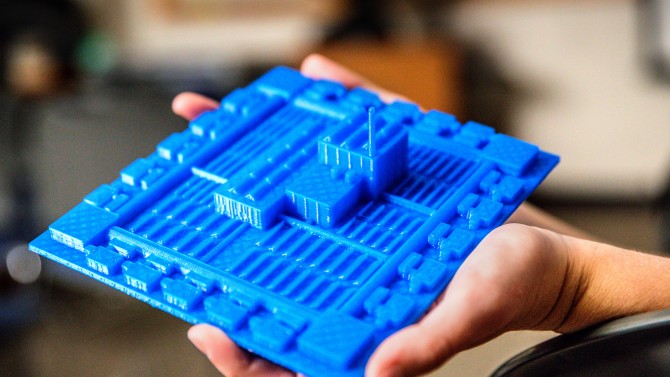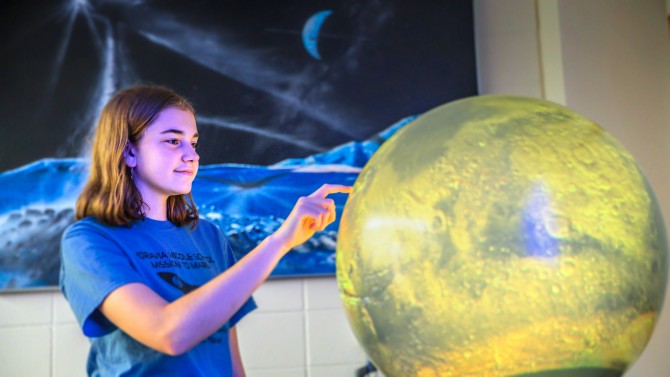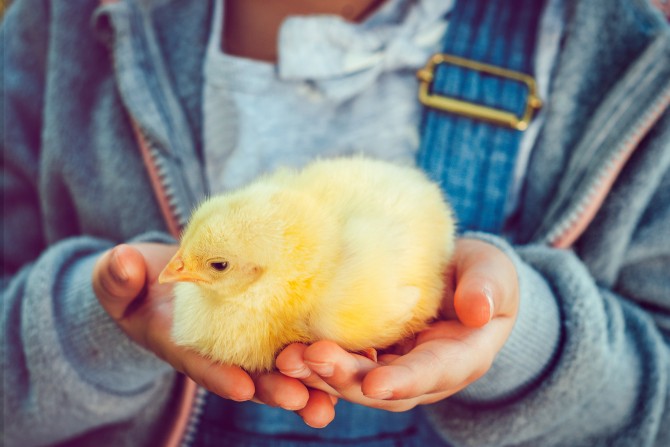From fish DNA to Mars: STEM programs inspire kids across NYS
By Merry R. Buckley
Living on Mars would be “the coolest thing ever,” says Taryn Langtry, a student at Moravia High School. On a trip to Cornell’s Spacecraft Planetary Imaging Facility last year with her eighth-grade science class, she was astonished to learn that the red planet might actually be within reach in her lifetime.
“I always thought it was super impossible to get to Mars, but after that workshop I thought maybe we’ll actually get there some day,” says Langtry. “We learned about how we could die on Mars, then we got to brainstorm ways to survive, and we put all our ideas together in groups.”
Moravia Middle School teacher Megan Newhouse used the Cornell University program, better known as “SPIF” to its would-be spacemen and spacewomen, as the keystone of a semesterlong project about Mars. Children here on Earth have been exploring space through SPIF’s programs for almost 40 years, says SPIF data manager Zoe Learner Ponterio. With programs on Cornell’s campus and in school classrooms all over the region, SPIF shares images and data from NASA’s past and present planetary missions, artifacts and space-exploration technology with roughly 4,000 school-age children every year – enrichment programs that help bring the excitement and possibility of space to New York state’s next generation.
“One of my favorite parts of the job is hearing the amazing response from kids,” says Ponterio. “You can see it in their faces – they can suddenly see themselves being a part of this someday. Some kids – especially young girls – come up and hug me after these workshops. There’s the feeling you’ve made this impact; it’s an amazing thing to see.”
SPIF’s outreach programs are just one example of science, technology, engineering and math (STEM) programs Cornell carries out all over New York state that help children get a leg up in a wide variety of fields. From space exploration to computer coding workshops to molecular biology lessons in the field, these programs enhance the educational experience and open up new career possibilities for thousands of students ranging from preschool age up through high school.
“Public engagement is a core value of Cornell,” says Katherine McComas, vice provost for engagement and land-grant affairs. “These STEM programs enable us to connect with educators and students across New York state and beyond.”
Reaching counties across New York state
From the Grass River near the border with Canada to the Hudson to the tributaries of the Allegheny River in the Southern Tier, the FishTracker program gets children out of the classroom for hands-on science in the great outdoors. Participating students sample surface water in the search for traces of DNA from invasive fish species, essentially becoming citizen scientists who help Cornell track the locations of invasive fish in New York’s waterways.
“The idea that they were doing something meaningful and collecting samples that would be used and are part of science happening now made the students much more engaged than if we just talked about invasive fish species or analyzed data that had nothing to do with them,” says Laura Austen, a biology teacher at Ernie Davis Academy in Elmira, which draws students mostly from urban neighborhoods. Austen took her ninth-grade biology students on a field trip to Cayuga Lake to sample water at Taughannock Falls State Park. “Kids love doing ‘real’ science. They were able to see what and where invasive fish were on the website map, and now our results are there as well.”
“Last year, we were walking back from the stream, and I mentioned to a student that it was an easy day for us, since we weren’t in the classroom,” says Pamela Patterson, a teacher at Holland Senior High School in western New York, whose 12th-grade class collected samples near their school. “And my student replied, ‘Actually, we’ve done more “real” science today than we have all school year!’”
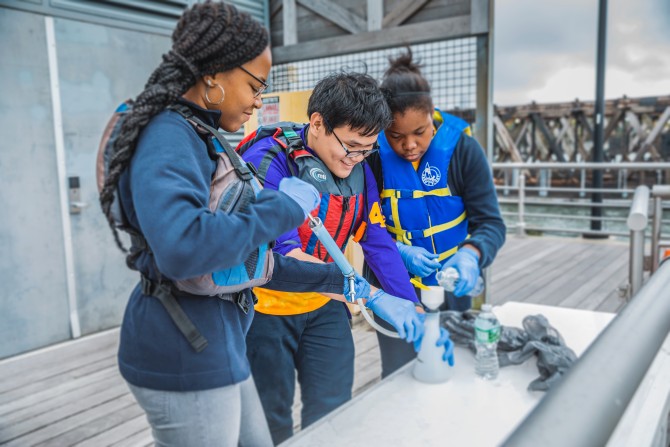
Students from Loughlin Memorial High School in New York City sample water from the Hudson River to help identify invasive species for the FishTracker program.
“It’s a hands-on project, so the kids aren’t just reading about invasives, they’re doing work that means something – they’re working with Cornell scientists. We’re trying to fuse research and education in a way that will benefit both,” says Donna Cassidy-Hanley, senior research associate at Cornell’s College of Veterinary Medicine, who advises teachers statewide about field science and administers the FishTracker program. Cassidy-Hanley and her team provide classrooms with a kit for every sampling site, which students use to filter surface water samples to capture cellular debris. They then send those filters back to Cornell for analysis. Since FishTracker began in 2016, more than 94 teachers have participated, sending in samples from over 400 different sites in New York state to Cornell, where they are analyzed for the presence of DNA from six different invasive fish species and two native species.
For kids in cities and suburbs far away from babbling brooks and lakes, farm animals offer a fun and hands-on way to learn about biology. Like educators around the state, every spring Cathy Revellese, the librarian at Creston Academy in the Bronx, gets fertilized eggs, educational materials and technical support from her local Cornell Cooperative Extension office. When the chicks and ducklings begin to emerge from their shells a few weeks later, children gather around the glow of the incubators for a firsthand lesson in developmental biology.
“Even the big eighth-graders go crazy with the chicks and the ducks. The kids learn so much about their life cycles, their growth and development, the daily changes within the eggs. The little ones use the correct terminology – the vocabulary they learn is just amazing. This is great for them – they’ve got their own little farm right at the school,” says Revellese, who offers educational opportunities in the library to complement their classroom learning.
Revellese’s local office, CCE of Westchester County, administers the 4-H Incubation and Embryology Project for more than 450 classrooms in the region, and other Cornell Cooperative Extension offices run similar embryology programs for classrooms throughout the state, reaching more than 13,000 schoolchildren with hands-on science learning opportunities.
“Every year I hope that [embryology program coordinator] Nancy Caswell and CCE will continue the program. Nancy has been my guardian angel. If I ever have problems with the hatching process, like a chick that was born with a bad leg, I can call Nancy for help,” says Revellese.
“It wouldn’t be the same school year without ending it with the chick and the duck project. The stories and the memories we created from this learning experience are endless,” she says.
All told, 56 Cornell Cooperative Extension offices in New York state employ extension professionals such as Caswell who work in local communities, reaching students in kindergarten through 12th grade with a variety of educational programs in nutrition, agriculture and other fields – STEM programs that reach more than 140,000 New York state students every year.
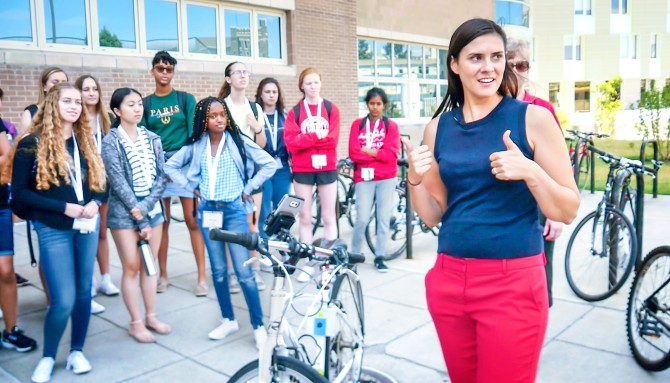
Director of Innovation for the city of Syracuse Adria Finch discusses smart cities with CURIE Academy participants.
Boosting girls and underrepresented minorities
“The first time I learned about mechanical engineering … was yesterday,” says Nia Wallace, 16. As a participant in the CURIE Academy this July, Wallace says her eyes were opened to the variety of careers available to someone with math and science skills, knowledge that she says is illuminating her path forward to a future career. A program of Cornell’s College of Engineering, the CURIE Academy brings 45-50 high school girls who excel in math and science to campus for one week every summer to participate in hands-on learning exercises and learn about opportunities in engineering.
“I would encourage other girls to apply,” says Wallace, who is a student at the Frederick Douglass Academy in Manhattan. During her week at the CURIE Academy, Wallace says she was inspired not only by the faculty presenters, but also by the other program participants, who embody what a smart woman in STEM can be.
From engineering programs such as the CURIE Academy to ongoing programs in astronomy, biology and math, Cornell’s outreach programs to schools and K-12 students cover a wide range of STEM fields.
“I wanted a better idea of what I [could] become, because my ideas change every month,” says Wallace. “Mechanical or civil engineering and sustainability engineering interest me now because they are about the future – finding alternative sources of power and ways to live a more sustainable life. Engineering is broad, and it’s a promising career.”
An interest in computer science is what drew Alaina Strife to Cornell for the chance to study a field she couldn’t get enough of at her high school in Horseheads, New York. Strife signed up for classes with Cornell’s Girls Who Code, part of a national network that is empowering young women to pursue their interests in computer science and technology. Strife attended a series of classes and worked with volunteers in the Women in Computing at Cornell program to complete a coding project, the type of assignment often handed out to first-year students at Cornell, says Strife.
“My school only has one programming course, and unfortunately it’s not run every year because of a lack of interest,” says Strife. “Even though I live 40 minutes away [from Cornell], I thought it was definitely worth it because it provided a great insight into the basics of coding.” Having graduated from high school in June, Strife is attending Penn State this fall to further pursue her interest in computer science.
“My family is very excited for me,” says Strife.
The Girls Who Code program at Cornell is administered by Women in Computing at Cornell, a student group dedicated to making computing inclusive for all.
Computer science is also a subject taught by Cornell graduate students who volunteer in the GRASSHOPR program, which pairs graduate students from across the university with teachers in local schools to create age-appropriate lesson plans and teach schoolchildren about their areas of expertise. In the 2017-18 school year, GRASSHOPR’s graduate students taught 121 lessons in 17 different schools in the Ithaca region.
“I was fortunate enough to match with a student who teaches ‘understanding our brains,’” says Janice Beckley, who teaches science at Trumansburg Middle School. “The graduate student gave lessons on our brain, optical illusions and how our brains respond to stimuli.”
“Grad students bring with them an excitement that is infectious,” says Ashley Paolangeli, who invites GRASSHOPR volunteers to teach her fifth-grade classes at Belle Sherman Elementary School in Ithaca every year about such subjects as food systems, the water cycle and birds. “They’re teaching about the subject they are becoming experts on, something they’re passionate about, and that really resonates with the students.”
No matter the field, outreach programs such as Girls Who Code and GRASSHOPR are a win-win for the students they serve and for Cornell student volunteers, says Vice Provost McComas.
“These experiences can be transformative for our students,” McComas says, because they provide Cornell’s student researchers with teaching opportunities and the chance to demonstrate mastery of their subject matter, an important professional skill in any field.
Statistics from the U.S. Department of Commerce and from the Pew Research Center show that STEM fields aren’t as accessible to women, African-Americans and Hispanics as they are to white men. For the students who volunteer with the Girls Who Code program, the willingness to engage with the local community puts them on the front lines of an effort to end these long-standing disparities in the tech sector.
“Often times women don’t pursue computer science because of a lack of confidence. One of our main goals is developing that confidence,” says Emma Dana Clark '20, a junior in computer science who manages the Girls Who Code program and other computer science workshops for middle- and high school-aged girls. The national Girls Who Code program points to the fact that women make up only 24 percent of the computer science workforce today, down from 37 percent in 1995, a declining representation that discourages young women from pursuing their interest in the field and limits the talent pool the tech industry needs to flourish.
“It’s hard to be a female or a member of a minority group in tech because you look at the field and don’t see many people like you. I think it’s really important for young women and minorities to have someone to look to so that they can say, ‘That person is like me, and if they can do it I can do it too,’” says Clark.
Cornell’s Girls Who Code program aims to put role models in front of girls, giving them a real-life, relatable picture of what their path forward can be, she says.
Jami P. Joyner, director of Diversity Programs in the College of Engineering, agrees that role models are crucial. The Office of Diversity Programs in Engineering administers the CURIE Academy and the Catalyst Academy, a weeklong program for young people interested in STEM fields who aspire to be the first in their families to go to college or are members of underrepresented minority groups.
“Our undergraduate population is now 50 percent female, which is phenomenal considering the national average enrollment for women in engineering departments is about 22 percent,” says Joyner. Programs by the Department of Mathematics, the Cornell High Energy Synchrotron Source and a number of groups on campus also run programs specifically aimed at increasing the number or girls and underrepresented minorities in STEM professions.
“Having access and exposure to world-renowned engineers and having students who look like them as role models are crucial for improving the numbers of women and minority students in the pipeline and enhancing their numbers in the work force,” says Joyner.
“The tech sector has grown by leaps and bounds. We should look broadly to increase access for women and minorities to fill those opportunities,” she says.
Moravia High School student Langtry says her visit to SPIF opened her eyes to new career possibilities.
“I always dreamed about becoming some kind of scientist,” says Langtry. “But this [workshop] made me think I could become an astronaut or someone who works with astronauts, helping us get to Mars someday. But I have some time to decide.”
New York State Impact
From fish DNA to Mars: STEM programs inspire kids across NYS
Media Contact
Get Cornell news delivered right to your inbox.
Subscribe